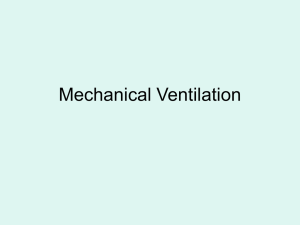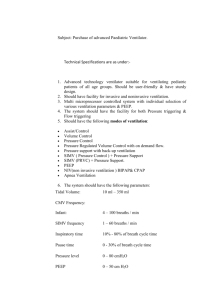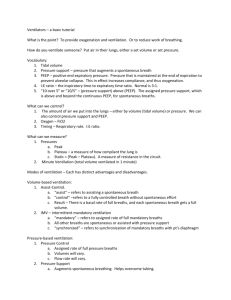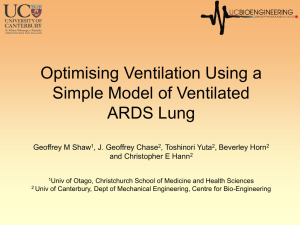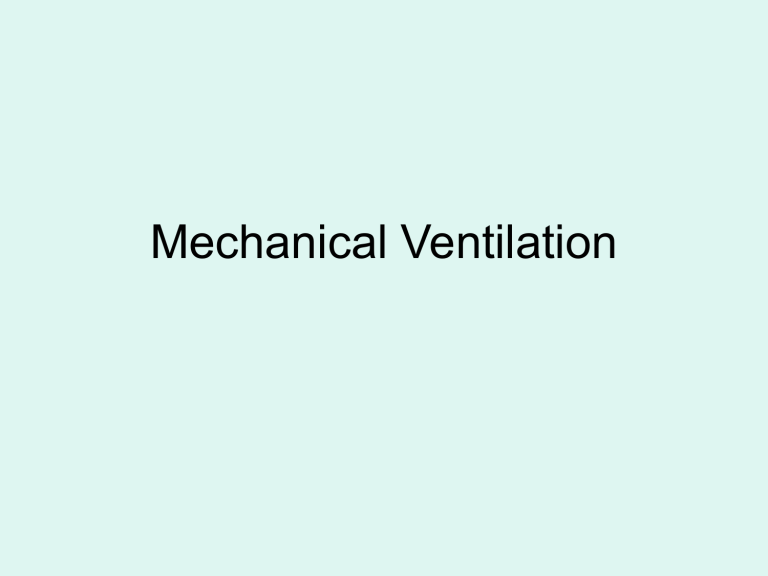
Mechanical Ventilation Epidemiology • 28 day international study – 361 ICUs in 20 countries – All consecutive adult patients who received MV for > 12 hours – 33% Patient admitted to those ICUs received mechanical ventilation • Mean age 59 • M > F (61 v. 39%) Esteban et al. JAMA 2002 • Indication for mechanical ventilation – Acute respiratory failure 68% • • • • • • • • Post-op (21%) Pneumonia 14% CHF 10% Sepsis 9% Trauma 8% ARDS 4.5% Aspiration 2.5% Cardiac arrest 1.9% – Acute on chronuic respiratory failure • COPD 10% • Asthma 1.5% • Chronic respiratory disease (non_COPD) 1.8% – Coma 16.7% – Neuromuscular disease 1.8% Ventilator Modes Used Each Day During the Course of Mechanical Ventilation Esteban, A. et al. JAMA 2002;287:345-355. Copyright restrictions may apply. • Duration of mechanical ventilation – Overall 5.9days – COPD pts 5.1 days – ARDS pts 8.8 days • ICU LOS: 11.2 days • Hospital LOS: 22.5 days • Mortality: – ICU mortality 30.7% – Hospital mortlaity 39.2% Kaplan-Meier Curves of the Probability of Survival Over Time of Mechanical Ventilation Esteban, A. et al. JAMA 2002;287:345-355. Copyright restrictions may apply. Mechanical ventilation • Physiology: – Positive pressure ventilation versus naturanl negative pressure ventilation • Effects: – Heterogeneous ventilation • Preferential ventilation of the non-dependent regions – Increased physiologic dead space – Improvement of physiologic shunt causes by atelectasis and/or alveolar filling – Rapid disuse atrophy of the diaphragm – Impairment of mucociliary clearance • Cardiovascular effects: – Decreased venous return • Exacerbated by: – – – – Auto-PEEP Applied PEEP Intravascular volume depletion Cardiac tamponnade – Increased right ventricular afterload: • Compression of the pulmonary vascular bed Increased PVR – May decrease left ventricular afterload • Lung exansion decreased extramural pressure Mechanical ventilation • Benefits – Improves gas exchange by improved V/Q matching predominantly be decreasing shunt – Decreased work of breathing Mechanical ventilation: Complications • Barotrauma – Incidence ~3% – To Avoid: Keep plateau pressure < 35 cm • VILI – Over stretch – Atelectotrauma • Auto-PEEP • Asyncrhony Mechanical ventilation: Modes • Choices: – Mandatory v. non-mandatory • Mandatory – Volume v. pressure limited ventilation – Mandatory rate – Modes: » SIMV » Assist Control » PCV » Hybrid Modes: PRVC, SIMV/PRVC • Non-mandatory or assisted breaths – PSV Variables: some default values • • • • • • Trigger sensitivity: -1 to -3 cm Tidal volume: 6-8mg/kg/IBW Rate: 10 to 14 PEEP: 5 cm H2O Flow rate: 60 L/min I to E ratio Volume limited v. pressure limited • Volume limited – Physician sets: • Tidal volume • Rate – Guaranteed constant tidal volume – Guaranteed minute ventilation – High peak pressures • Pressure limited – Physician sets: • Peak airway pressure • Inspiratory time – Tidal volume and minute ventilation depends entirely on patient factors: compliance and airway resistance – Associated with lower peak airway pressure – Associated with more homogenous gas distribution No difference in mortality, oxygenation, or work of breathing P = Vt/CR + Vt/Ti * R + PEEPtotal Where CR = compliance of the respiratory system, Ti = inspiratory time and VT/Ti = Flow, RR = resistance of the respiratory system and PEEP total = the alveolar pressure at the end of expiration = external PEEP + auto (or intrinsic) PEEP, if any. Auto PEEP = PEEP total – P extrinsic (PEEP dialed in the ventilator) adds to the inspiratory pressure one needs to generate a tidal breath. • Peak pressure • Plateau pressure – Surrogate for peak alveolar distending pressure • Peak – Plateau – Resistive pressure • Mean airway pressure – Pressure applied acorss the lung and chest wall averaged throughout the ventilary cycle • Patient factors: – Airway resistance – Compliance of the respiratory system • Chest wall recoil • Lung recoil Assist-Control • Set variables – Tidal volume – Flow rate or Ti – PEEP FiO2 – Mandatory rate • Spontaneous breaths – Additional cycles can be triggered; they are identical to the mandatory breath SIMV • Set variables – – – – – – Targeted volume Flow rate Manatory frequency PEEP FiO2 PS augmentation for spontaneous breaths • Spontaneous breaths – Unrestricted and aided by the selected level of pressure support PCV • Set variables: – Peak pressure – Inspiratory time – Frequency of mandatory breaths • Spontaneous breaths – PCV (AC): same as mandatory breaths – PCV/SIMV: unsupported or pressure supported Tidal volume during PCV • Changes in mechanics – Increased airway resistance – Decreased respiratory system compliance • Increased auto-PEEP • Decreased inspiratory time Waveforms Waveforms Waveforms Waveforms Ventilator change Flow (lpm) Pressure (cm H2O) Volume (mL) Waveforms Airway pressure 40 30 Pause 20 10 0 Time Waveforms Pause • What changes on the ventilator should you make for hypoxemia? • What changes for hypercapnia and respiratory acidosis? • Hypotension on the ventilator?
